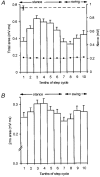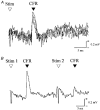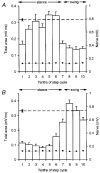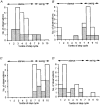Gating of transmission in climbing fibre paths to cerebellar cortical C1 and C3 zones in the rostral paramedian lobule during locomotion in the cat
- PMID: 10200433
- PMCID: PMC2269295
- DOI: 10.1111/j.1469-7793.1999.0875u.x
Gating of transmission in climbing fibre paths to cerebellar cortical C1 and C3 zones in the rostral paramedian lobule during locomotion in the cat
Abstract
1. Climbing fibre field potentials evoked by low intensity (non-noxious) electrical stimulation of the ipsilateral superficial radial nerve have been recorded in the rostral paramedian lobule (PML) in awake cats. Chronically implanted microwires were used to monitor the responses at eight different C1 and C3 zone sites during quiet rest and during steady walking on a moving belt. The latency and other characteristics of the responses identified them as mediated mainly via the dorsal funiculus-spino-olivocerebellar path (DF-SOCP). 2. At each site, mean size of response (measured as the area under the field, in mV ms) varied systematically during the step cycle without parallel fluctuations in size of the peripheral nerve volley. Largest responses occurred overwhelmingly during the stance phase of the step cycle in the ipsilateral forelimb while smallest responses occurred most frequently during swing. 3. Simultaneous recording from pairs of C1 zone sites located in the anterior lobe (lobule V) and C1 or C3 zone sites in rostral PML revealed markedly different patterns of step-related modulation. 4. The findings shed light on the extent to which the SOCPs projecting to different parts of a given zone can be regarded as functionally uniform and have implications as to their reliability as channels for conveying peripheral signals to the cerebellum during locomotion.
Figures






Comment in
-
Climbing fibres - a key to cerebellar function.J Physiol. 1999 May 1;516 ( Pt 3)(Pt 3):629. doi: 10.1111/j.1469-7793.1999.0629u.x. J Physiol. 1999. PMID: 10200411 Free PMC article. No abstract available.
References
-
- Apps R. Movement related gating of climbing fibre input to cerebellar cortical zones. Progress in Neurobiology. 1999;57:537–562. 10.1016/S0301-0082(98)00068-9. - DOI - PubMed
-
- Apps R, Lee S. Movement-related gating of spino-olivocerebellar paths in the awake cat. The Journal of Physiology. 1997;504.P:16–17S.
Publication types
MeSH terms
Grants and funding
LinkOut - more resources
Full Text Sources
Miscellaneous

